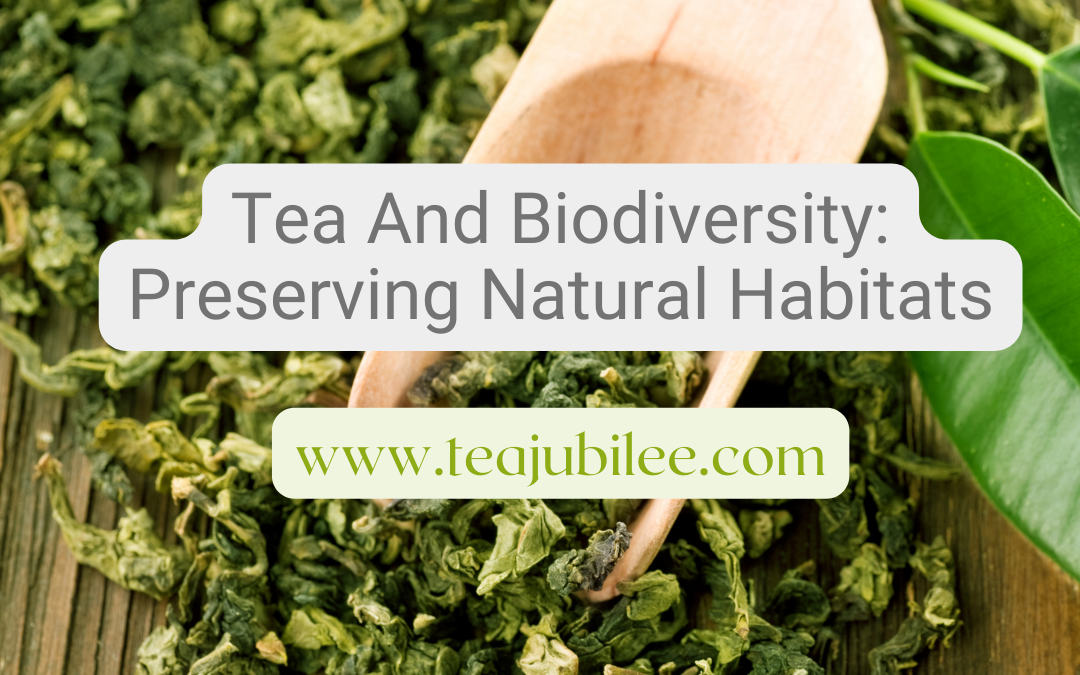==================
A Caveat and Affiliates
First off, a little caveat: within my articles you will find affiliate links, meaning if you buy them, I get a small commission. Your cost is not affected. In addition, I am an Amazon Associate and I earn from qualifying purchases on Amazon.
And yes, if I say that I recommend a product here, it means I truly believe it is a good product. I refuse to recommend any product that I have not researched and believe to be a good value.
Even better, I provide you with a very clear picture of the product, it’s use, and the probable value.
Earning your trust is important to me. I run this website myself and the commissions and donations help support the site.
Sound reasonable and fair enough? Let’s continue to the article.
==================
Contents
Tea And Biodiversity: Preserving Natural Habitats
Do you know what tea and biodiversity are all about? Find out about this and why it’s so important to this world.
Keep reading this post to learn more about what Tea And Biodiversity can do for our wonderful planet!
I will give you a glimpse into the intricate relationship between tea cultivation and the broader ecological tapestry surrounding it. Tea, a beloved beverage worldwide, grows in regions that are also incredibly diverse biologically. The lush tea fields we picture are often nestled among vibrant forests, and they host an array of flora and fauna that contribute to regional biodiversity.
The ecological significance of diverse plant species stretches beyond life’s beauty or visible interplay. Biodiversity within these tea landscapes is crucial because it ensures the stability and resilience of ecosystems. It plays a defining role in nutrient cycling, water purification, and pollination, all essential for healthy tea growth.
What’s fascinating is how tea plantations, when managed with care, can become havens for local wildlife. The tea plants and the varied vegetation that can be cultivated offer shelter and nourishment to various species, from insects to mammals. This harmonious existence illustrates the potential for agricultural spaces to support, rather than displace, natural biodiversity.
The Impact of Tea Farming on Natural Habitats
The first part of this post about Tea And Biodiversity will dive into the impact of tea farming on natural habitats.
Tea farming, like all agriculture, reshapes the environment. If not managed carefully, it can lead to deforestation, soil erosion, and countless species’ habitat loss. This section explores how tea cultivation can both benefit and challenge natural habitats.
Let’s look at different areas of the world where tea farming has been a double-edged sword. In some cases, traditional methods support a mosaic of habitats, providing a refuge for local flora and fauna.
Yet, in others, introducing non-native plant species for tea production has disrupted the native ecological balance.
Land-use changes are a significant concern, especially when forests are cleared for new plantations. This fragments the habitats and threatens biodiversity by isolating animal populations and altering the local climate. Understanding these consequences is essential to foster practices that minimize environmental damage.
However, it’s not all doom and gloom. The next section will highlight successful strategies for biodiversity conservation within the tea industry. By examining sustainable farming techniques and the role of certifications, we’ll see how biodiversity can flourish alongside commercial tea production.
Strategies for Biodiversity Conservation in Tea Production

Sustainable farming practices are crucial in merging tea production with biodiversity conservation. Incorporating organic farming techniques, such as avoiding synthetic pesticides and fertilizers, helps preserve soil health and protect local species.
Shade-grown tea is another practice that bolsters biodiversity. By growing tea plants under the canopy of native trees, farmers create a more complex habitat that benefits insects, birds, and other wildlife.
Water management also plays a pivotal role. Tea plants require substantial water, so implementing irrigation systems that minimize waste can help mitigate the impact on surrounding ecosystems.
Implementing buffer zones, strips of vegetation around the plantation that isn’t cultivated serves as a sanctuary for wildlife and helps prevent erosion and water pollution.
Certifications like Rainforest Alliance or Fair Trade can guide consumers in choosing tea that supports biodiversity. These labels indicate adherence to stringent environmental standards.
Consumer choices have the power to drive industry practices. A preference for sustainably grown tea encourages producers to adopt methods that favor biodiversity.
Partnerships between tea producers and environmental organizations can also yield innovative conservation strategies. These collaborations often result in shared knowledge and resources benefiting the tea industry and ecological preservation.
Success Stories: Tea Plantations and Biodiversity Hotspots

You’ll learn about some tea estates that aren’t just producing high-quality tea but also showcasing a deep commitment to protecting biodiversity. These plantations often become havens for local flora and fauna, contributing to conservation in impressive ways.
One such example is found in the tea gardens of India and Sri Lanka, where harmonious practices have turned monoculture farms into agroforestry models teeming with life. Here, native trees and shrubs are nurtured alongside tea plants, creating corridors for wildlife and preventing soil erosion.
The connection between biodiversity and the quality of tea is undeniable. A plantation rich in varied plant life supports a healthier ecosystem, which sustains the tea plants. Healthier plants produce better leaves and, thus, a superior tea.
Economic gains come hand in hand with these eco-friendly practices. Farms that embrace biodiversity often see reduced costs due to natural pest control and soil fertility management. Plus, there’s a growing market demand for sustainably produced goods.
If you choose something that resonates with you, like tea that helps preserve the environment, you’re already contributing to the cause. Eco-conscious farming isn’t just a buzzword; it’s proving to be a sustainable business model for tea producers globally.
I hope that stories like these inspire more tea gardens to follow suit. Now, let’s explore what the future might hold for the industry and how we can all be a part of birthing a new era of tea that treasures the earth it comes from.
The Future of Tea: Embracing Biodiversity Preservation

I will take you through the challenges and opportunities that lie ahead in the tea industry, emphasizing biodiversity preservation. It’s a complex topic that’s incredibly important for the future of tea and the planet.
There are several challenges we must acknowledge. Climate change poses a serious threat to biodiversity and the sustainability of tea plantations. Additionally, the ever-increasing demand for tea can pressure growers to expand into wild areas, further threatening local ecosystems.
However, it’s not just about the challenges; it’s also about the potential for transformation. Technology could be a game-changer, offering tools for better monitoring the health of ecosystems and creating more efficient, sustainable farming practices.
You’ll find out how consumers play a pivotal role in this process. By opting for sustainably produced tea, consumers can directly influence industry practices and encourage the adoption of biodiversity-friendly methods.
Remember, your first attempt at choosing sustainable products doesn’t need to be your last. You can always adjust your approach down the road. However, making the first step towards supporting sustainable tea production is crucial.
In my opinion, the future of tea hinges on a collective effort: producers, consumers, and organizations must work together to preserve our natural habitats. This isn’t just about ecological responsibility; it’s about securing a resilient and rich future for the tea industry and its myriad of beneficiaries.
More From Tea Jubilee.
Sustainable Farming Practices In The Tea Industry
And that’s all for today!
Thank you for reading my blog post about tea and biodiversity. If you find this helpful, please give me feedback in the comments below.
Have a great day!




